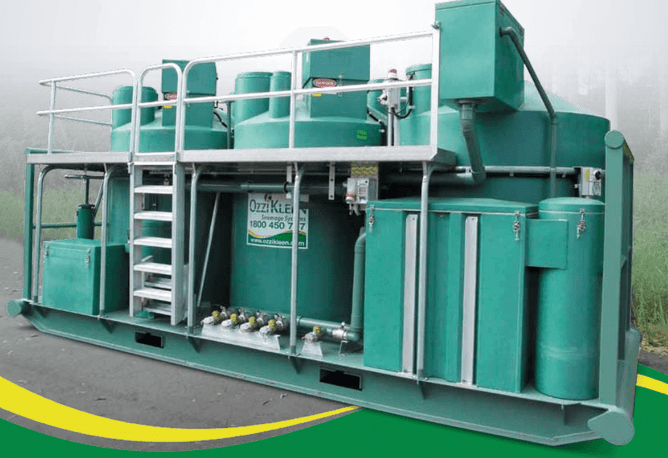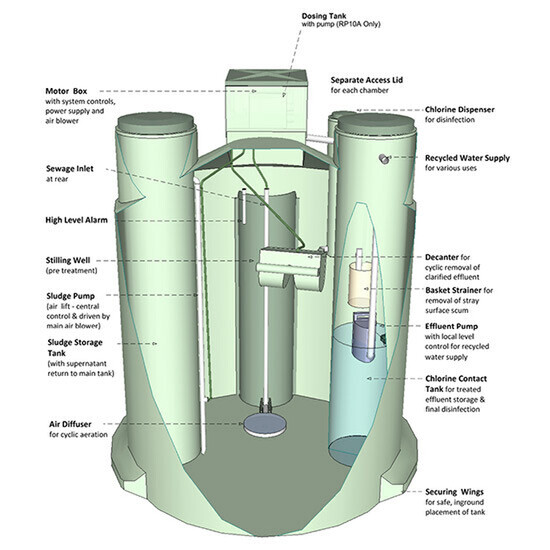At DrainPro, we've seen how commercial wastewater treatment systems have evolved to handle remarkable capacities, from 10 to over 2,000 persons daily. Whether you're managing a busy hotel, operating a business facility, or running a shopping centre, these systems now process anywhere from 2,000 to 200,000 litres of water per day.
With over four decades of research and development behind modern treatment systems, we understand the critical role they play in commercial operations. These robust, compact solutions offer quick mobilisation and utilise advanced cyclic control processes, making them essential for businesses requiring reliable wastewater management.
In this comprehensive guide, we'll explore everything you need to know about commercial wastewater treatment systems. From understanding the basics to selecting the right solution for your business, we'll help you navigate the complexities of wastewater management whilst ensuring compliance with current standards.
Understanding Commercial Wastewater Treatment Basics
Commercial wastewater requires specialised handling and treatment. At DrainPro, we recognise that understanding the fundamentals is crucial for making informed decisions about your treatment systems.
What constitutes commercial wastewater?
Commercial wastewater encompasses all liquid waste generated by businesses, factories, and industrial operations. Unlike residential wastewater, commercial effluent contains a complex mix of contaminants that vary significantly depending on the industry. These typically include chemicals, heavy metals, microorganisms, oil, grease, sand, and suspended solids.
Manufacturing facilities, energy production plants, and diverse industrial processes are major sources of commercial wastewater. Food production operations generate high loads of organic matter and soluble chemicals, while chemical industries produce effluents containing phenols, sulphides, and various metals.
In New Zealand, trade waste specifically refers to commercial and industrial liquid waste discharged into wastewater networks for treatment. This type of waste carries more risks than residential wastewater, making proper management essential.
Why proper treatment is essential for businesses
Untreated commercial wastewater poses significant risks to human health and the environment. Contaminants can pollute rivers and lakes, harm aquatic life, and potentially affect water quality in surrounding areas. Additionally, improperly treated waste can contribute to air pollution through methane release.
For businesses, compliance isn't merely a regulatory checkbox, it's a necessity. Non-compliance can result in severe penalties, including fines, legal action, suspension of permits, and significant reputational damage. Furthermore, implementing efficient wastewater treatment systems can reduce energy costs by up to 30%, making it financially beneficial beyond mere compliance.
In today's climate of increased scrutiny, proper wastewater management also protects your business reputation with environmentally-conscious consumers.
Key regulations affecting NZ businesses
The regulatory framework in New Zealand has evolved significantly over time to shape the management and control of trade waste. Businesses must comply with regional bylaws like the Auckland Trade Waste Bylaw 2013 and Trade Waste Control 2019.
Key compliance requirements include:
Volume limitations (typically 2-6 m³/d depending on permit type)
Minimum discharge quality standards (20 g/m³ Biochemical Oxygen Demand, 30 g/m³ Suspended Solids)
Separation distances from water bodies (at least 20m from rivers, lakes or wetlands)
Regular monitoring and maintenance documentation
For many commercial operations, obtaining appropriate discharge permits is mandatory. These permits outline specific limits on pollutant types and concentrations while establishing monitoring and reporting requirements.
At DrainPro, we help businesses navigate these complex regulations while implementing effective treatment solutions that protect both your bottom line and the environment.
Types of Commercial Wastewater Treatment Systems
Choosing the right wastewater treatment technology is crucial for commercial operations. At DrainPro, we recommend several proven systems based on your specific needs.
Aerated wastewater treatment systems
Aerated wastewater treatment systems (AWTS) provide enhanced treatment compared to conventional septic systems. These systems operate through three main processes:
Settlement and anaerobic treatment where solids settle and break down
Aerated treatment where aerobic bacteria reduce harmful components
Final settlement (clarification) before pumping to disposal
Our CP2 Aerated systems can process up to 2000L daily, sufficient for commercial facilities with up to 10 people. Consequently, they're ideal for businesses in areas with high groundwater tables requiring protection.
Sequencing batch reactors (SBR)
SBRs treat wastewater in batches rather than continuous flow. This compact process works through six sequential steps:
Primary chamber collection
Transfer to SBR tank
Aeration with activated sludge
Rest phase for sludge settling
Discharge of purified water
Return of activated sludge to the first chamber
Moreover, SBRs can achieve 85-95% BOD removal efficiency and produce effluent with less than 10 mg/L BOD and 10 mg/L TSS. Their flexibility makes them particularly suitable for businesses with intermittent flow conditions.
Membrane bioreactors
Membrane bioreactors (MBRs) combine suspended growth biological reactors with membrane filtration. These systems come in two configurations:
Submerged MBRs using vacuum-driven membranes
Sidestream MBRs using pressure-driven membranes
MBRs require 50% less space than conventional systems and produce high-quality effluent free of suspended solids with reduced bacteria. Indeed, this makes them ideal for businesses needing to meet strict discharge requirements.
Key Components of Effective Treatment Systems
Every commercial wastewater treatment system relies on a sequential treatment approach to effectively clean wastewater. At DrainPro, we understand how each stage works together to produce safe, environmentally compliant effluent.
Primary treatment processes
The first stage in effective wastewater treatment involves physical separation of solids from wastewater. These mechanical processes employ screens and grit chambers to remove large debris that could damage downstream equipment. Primary clarifiers or sedimentation tanks then allow suspended solids to settle via gravity.
Primary treatment typically removes 50-65% of suspended solids and 30-40% of the biological oxygen demand (BOD). This critical initial phase not only safeguards equipment but prepares the wastewater for biological treatment by removing materials that might interfere with microbial activity.
Secondary biological treatment
Following primary treatment, secondary biological processes utilise microorganisms to break down dissolved organic matter. This stage can remove over 90% of remaining suspended solids, substantially improving water quality through natural biological action.
Three main approaches exist for secondary treatment:
Aerobic treatment uses oxygen-requiring microorganisms and aeration systems to convert contaminants into water, carbon dioxide and additional microbes
Anaerobic treatment works without oxygen, often producing useful biogas byproducts
Anoxic treatment operates without free molecular oxygen but can use oxygen from compounds like nitrates, making it excellent for nitrogen reduction
Tertiary filtration and disinfection
The final purification stage removes remaining contaminants before discharge. Tertiary filtration employs various technologies including sand philtres, membrane systems, and cloth philtres to eliminate fine particles. This process typically reduces total suspended solids to concentrations of 5-10 mg/L.
Disinfection methods such as UV radiation, chlorination or ozonation then destroy any remaining pathogens. UV disinfection offers a chemical-free approach, using ultraviolet light to neutralise microorganisms without affecting water composition.
Throughout our years of experience, we've found that well-designed systems incorporating all three treatment stages deliver the most reliable performance, especially for businesses with stringent discharge requirements or those located near sensitive water bodies.
Selecting the Right System for Your Business
Finding the ideal commercial wastewater treatment system requires careful analysis of several critical factors. At DrainPro, we guide businesses through this decision-making process to ensure optimal performance and regulatory compliance.
Assessing your wastewater volume and composition
To begin with, accurately calculating your daily wastewater volume is essential for proper system sizing. An average New Zealander uses 160–250 litres of water daily, whilst commercial operations typically require an additional 15% capacity allowance.
For businesses, we calculate flow rates based on the number of discharge units and their frequency of use.
Your wastewater composition significantly influences treatment requirements. Primarily, you'll need to identify whether your effluent contains chemicals, heavy metals, or high organic loads.
This analysis helps determine which system—aerated treatment, sequencing batch reactors, or membrane bioreactors—will most effectively process your specific contaminants.
Space and installation considerations
The optimal location for your treatment system is typically at the lowest point of your site, where sewer lines naturally converge. Due to this requirement, site assessment becomes crucial before selecting equipment.
Subsequently, separation distances from buildings and other structures must be evaluated to meet regulatory standards.
For maximum flood protection, we recommend positioning the highest point of pressure pipes above potential flooding levels. This arrangement offers superior protection for valuable equipment, although systems located outside buildings may require additional space allocations.
Budget and long-term operational costs
Initially, budget considerations include both upfront investment and ongoing operational expenses. Quality construction materials significantly impact system longevity—high-quality materials minimise future maintenance costs, particularly for operations with corrosive wastewater or extreme temperatures.
Operational costs encompass:
Day-to-day expenses (labour, energy, chemicals)
Regular maintenance requirements
Compliance monitoring
Sludge disposal (which can represent up to half of total treatment costs)
For businesses with budget constraints, we often recommend aerated wastewater treatment systems that balance capital investment with reasonable operational costs. Nevertheless, the most economical choice ultimately depends on your specific wastewater characteristics and discharge requirements.
At The End of The Day
At DrainPro, we've witnessed firsthand how choosing the right commercial wastewater treatment system significantly impacts business operations. Through decades of experience, we understand that each business faces unique challenges regarding wastewater management.
Successful wastewater treatment relies on three key factors: accurate assessment of your needs, selection of appropriate technology, and proper system maintenance.
Whether your business requires an aerated system processing 2,000 litres daily or a robust membrane bioreactor handling larger volumes, we ensure your solution aligns with both regulatory requirements and operational goals.
Remember that wastewater treatment isn't just about compliance - it's an investment in your business's future. A well-designed system reduces operational costs, protects the environment, and safeguards your reputation.
Our team stands ready to help you navigate these choices, ensuring your business maintains efficient, compliant wastewater management for years ahead.
Phone:
phone 03 342 1278



